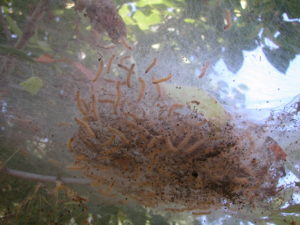By Todd Lanigan, forest health specialist, Eau Claire, WI. Todd.Lanigan@wisconsin.gov; 715-210-0150
Web-like nests of fall webworm (Hyphantrea cunea) caterpillars, a common native pest active from July through September, are beginning to appear in parts of the state. A common native pest throughout most of the U.S. and southern Canada, fall webworm caterpillars feed on leaves of almost all shade, fruit, and ornamental trees and shrubs, except for conifers. They typically form nests of loose webbing over the tips of tree branches. Although populations of fall webworm caterpillars are rarely large enough to cause lasting damage to trees, the presence of nests and feeding damage from caterpillars can greatly affect trees’ aesthetic value. Typically, trees recover from feeding damage on their own, but defoliation for more than two or three years in a row could make trees more susceptible to diseases and pests.
If intervention becomes necessary, one of the easiest ways to manage fall webworms is to simply tear open the nests with a rake or pole. This allows natural predators such as birds and other insects to reach caterpillars inside the otherwise impenetrable webbing. A rake or pole may also be used to roll up nests and remove them from the tree. Detached nests should be placed in a container of soapy water overnight to drown caterpillars. One may also simply scrape the nests off onto the ground and crush them to destroy the caterpillars. These actions are best undertaken in early morning or late afternoon when caterpillars are gathered in their nests.
Never attempt to burn the nests off the branches – this action will almost certainly damage the tree and may result in an uncontrolled fire and injury.
On small trees, where webbed branches are within reach, nests can be manually pruned out and destroyed. This is only practical if the webs have not become too large and the aesthetic shape of the tree will not be affected by pruning.

Fall webworm caterpillars in their nest, which contains excrement and debris. Photo: Todd Lanigan
On larger trees, pesticide treatments might be useful. Apply appropriate pesticides while caterpillars are inside the nest in the morning or late afternoon. Chemical treatments are most effective on small, young caterpillars such as those present in late July/early August. Larger, solitary caterpillars are harder to control with pesticides. When applying pesticides, it is important to make sure that the nest is completely penetrated. Always read and follow label directions for safe use of any pesticide
For more information on fall webworms, visit UW Extension at https://hort.uwex.edu/articles/webworms/ or Michigan State University’s Extension at http://msue.anr.msu.edu/news/the_rise_and_fall_of_the_fall_webworm.
